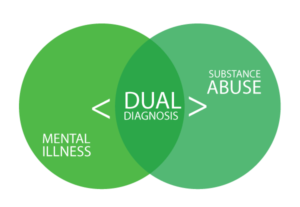What is Dual Diagnosis?

The theory of mental illness causing addictive behavior has been around for about twenty years Many suffering from PTSD may lead to self-medicate to escape flash backs. Someone that has body image issues and develops an eating disorder may also use drugs such as amphetamines to lose weight. It is very common for those suffering from depression to drink to reduce anxiety. This is where the dual part of dual diagnosis comes from. It refers to both the addictive substance behaviors and preexisting mental health issues. The addiction is thought to be a symptom of a larger underlying disorder, thus creating a compound issue. In dual diagnosis treatments, both the issues are addressed at the same time.
However, programs that treat conditions either sequentially or separately have a lower success rate than dual diagnosis treatment methods. Most Dual diagnosis treatments require an impatient facility. Without the change in lifestyle, patients will often go back to old habits, meet old contacts, or search out family that enabled past behaviors. Contributing factors that can lead to a dual diagnosis.
Common Risk Factors associated with Dual Diagnosis?
- Not managing an existing mental health condition
- Isolation at home or lacking supportive family and friends.
- Homelessness, this can have a double effect, from irregular eating and sleeping and isolation.
- Anxiety, stress, or an inability to prioritize and stay focused.
What do these factors look like?
Common disorders that lead to addiction are Schizophrenia, borderline personality disorder, PTSD, bipolar disorder, and depression. There is no cure for these mental conditions, however with treatment they can become more manageable. Ignoring them leads to the first factor on this list, not coping with pre-existing conditions.
During the past year, spending time with family and friends has become difficult. For many this has led to feelings of loneliness. Without any human connection the chance that addictive behaviors develop increases. This is because the people within our lives provide accountability, and improve the overall quality of life. they also reduce the desire to turn to alternatives to find fulfillment. Isolation is the second factor on the list.
The third factor, homelessness, presents two separate factors. Not only do homeless feel more isolation, but they also lack the resources used to cope with preexisting conditions.
The last factor is stress and anxiety. Both can increase with preexisting conditions and can become worse combined with any of the previous factors. Just like with preexisting mental illness, it is the managing of stress and anxiety that can lead to addiction. Playing sports with friends or engaging in other social or athletic hobbies are good examples of positive stress reduction.
To accurately diagnosis mental health conditions, those being assessed must be completely sober. This is because many drugs can mimic symptoms of psychological disorders. This can explain why dual diagnosis can become such an issue. Therefore, the research has shown that dual diagnosis treatment has the best chance of success.
If you think this blog was helpful or are dealing with addiction yourself, then please checkout our YouTube channel, it has many testimonials and we may be able to help you on your path to recovery.
